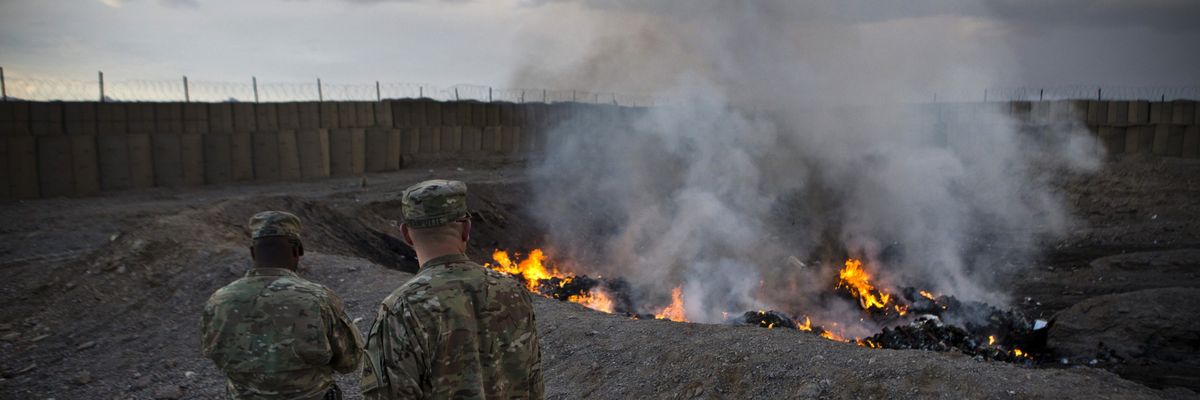It’s a headline that should, by all appearances, be considered “good news.” But somehow the November 18 declaration, “VA announces plans to study military toxic exposures, connections to veteran illnesses,” just comes off as an Onion-esque parody.
That’s because the Veterans Affairs Department has been vowing to “study” the effects of the ubiquitous "burn pits" on soldiers for more than a decade—so has the Pentagon. In fact, there have been tons of studies already, big and small, in both the public and private sectors. But like everything in Washington, launching one more study or task force allows the bureaucracy to stall real action—in this case, practical help for thousands of men and women who say they’re suffering from war-related illnesses.
Once upon a time, the lag time between when Vietnam veterans reported getting sick from Agent Orange exposure in the late 1970s to when the government began officially recognizing their illnesses, including cancer (in 1991), was considered the height of institutional inertia and neglect. In fact, many Vietnam veterans who did not fit the original parameters of the 1991 policy that made Agent Orange exposure a service-connected illness, affording them access to VA health care and disability compensation, are still fighting for their due.
But successive wars in the Persian Gulf, Iraq, and Afghanistan have created two new generations of veterans who have been mostly denied VA health care and disability benefits for their toxic exposures overseas. In other words, waiting as long if not longer than their Vietnam counterparts has merely become the new normal.
This includes some 250,000 Persian Gulf veterans, now mostly in their 50s and 60s, who are suffering from a variety of mysterious health conditions many medical experts now believe resulted from their exposure to widely used pesticides, the pyridostigmine bromide pills taken by troops to protect against sarin gas, and actual sarin gas exposure during the 1991 war. Outside studies have been conducted for more than 20 years now, with many finding direct correlation between service and illness. The VA has stepped up in so far as there is a way for these veterans to file service-connected claims, but the way the requirements are set up, it is still very difficult to actually get approved. According to one explosive report, some 80 percent of Gulf veterans’ claims were denied between 2010 and 2015.
Then there are the burn pits. For years after the wars in Afghanistan and Iraq began, the U.S. military dumped all of the trash accumulating on its massive U.S. forward operating bases into unregulated, unfiltered, open air pits. These pits, often the size of football fields or larger, burned everything from broken down vehicles, batteries, styrofoam, medical waste, food, paint cans, tires, you name it. They burned day and night, notable for the smoky haze and big black angry plumes. Tens of thousands of troops and other personnel worked and lived right next to these pits, unprotected, and many complained about coughing up “crud,” and getting sick right away when they arrived for the first time on base.
In one case, this author interviewed the wife of a soldier who, while stationed at Camp Taji in Iraq, began to lose all feeling in his feet. By 2009 he was home and confined to a wheelchair at the age of 49. VA doctors were flummoxed by his condition, finally diagnosing him with rheumatoid fibromyalgia. But his own neurologist believed, even at the time, that his condition was the result of nerve damage caused by toxic exposure.
That was 10 years ago. But now we know that there is fine particulate matter like heavy metals in the air around these unfiltered pits, and it was reported to Air Force officials as early as 2006 that it was an environmental health hazard. We know they sat on this information and even to this day will not acknowledge that the toxic air could be responsible for serious neurological and respiratory problems, not to mention cancer, among this cohort of veterans.
Congress believed it enough to shut down the burn pits in late 2009 after the stories like the one above started flowing from veterans’ blogs and into their offices on Capitol Hill. But despite the order, burn pits are still being used in the war zone today.
The VA was dragged, kicking and screaming, to set up a registry for which veterans could voluntarily register what they believed to be burn pit-connected illnesses. Since 2014, some 187,630 veterans have signed up as of this October. Meanwhile, the media is now rife with stories about young veterans dying of cancer, of wasting away in wheelchairs and with ever-present oxygen masks. A new report shows a spike in cancer rates among Iraq and Afghanistan veterans seeking VA care.
A class action suit by 800 veterans who wanted to hold the private contractor Kellogg, Brown, & Root responsible for the conditions caused by the burn pits went all the way up to the Supreme Court, but the justices wouldn’t hear the case.
Sadly, thanks to testing by private medical doctors, we know that the worst of the damage to vets is irreversible and that taking care of those who do not die as a result will cost the government billions over time. And here is the rub: between this generation, and that of the Persian Gulf veterans behind them, the VA is faced with liabilities that will stretch beyond today and decades into the future. There is every incentive to stall.
The American government should not have this luxury. When Washington made the decision to surge hundreds of thousands of troops into Vietnam, the Persian Gulf, Afghanistan and Iraq, it also entered into a covenant of care with those service members. Yes, this covenant has been broken many times before, but there is no reason to normalize the practice.
Had the government cared enough to find out what it was spraying, firing, burning and asking our troops to ingest, instead of treating them like guinea pigs, or worse, disposable, they would not be staring down the barrel of a trillion dollar gun. But here we are. It is up to us as citizens and policy makers to force some action, and say that “one more study” just won’t cut it.














